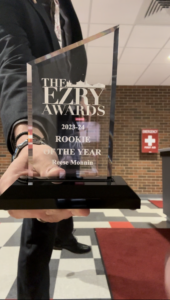The mood in front of the Portland Police Bureau on Sept. 26 was victorious. Earlier that day, a rally of the white supremacist group the Proud Boys at Delta Park had been expected to garner more than a thousand people, who would then take to the streets with the intent to “end domestic terrorism.” Instead, only between two and three hundred Proud Boys attended, while at Peninsula Park, a peaceful rally of 1,500 people, by some estimates, was organized by various left-wing organizations. At two other parks, hundreds of leftists gathered as well. Upon realizing the disparity in numbers, the Proud Boys ended their rally two hours early and went home. In front of the Police Bureau that night, protesters stood guard, protecting the autonomous zone that had sprung up in Lansdale and Chapman Square outside of the Bureau in case the Proud Boys decided to come back to Portland.
Atop a ledge in front of the Bureau, black leadership sat with a microphone, leading chants and speaking. What they made clear was that this night was not about the police. This night was about the Proud Boys, so they encouraged protesters to stay in the park and out of the street so as not to give police a reason to break up the gathering. For the most part, protesters followed that direction and the few cars that were out were able to pass through unhindered by protesters.
Without reason, a police car with a sound system on top of it appeared and blared a recorded message urging protesters to stay out of the street, which protesters were already doing. Naturally, this provoked protesters to take the street to defy the orders of the police car.
Until that point, the gathering had been entirely peaceful. The majority of the group had stayed in the park, but now with people in the street, the police were in vans, with motorcycles and in cars. They drove from around the corner, cleared out the street and stood guard as if the street was somehow their territory that protesters had impeded on.
Their numbers were comparable to those of the protesters. They lined the street holding clubs, cans of mace, guns, rubber-bullet guns and the like. As protesters chanted, some of the officers laughed in their faces. They shined flashlights to impede people’s ability to film. At one point, an officer commanded a photojournalist to turn off a light he had shining towards the police.
The recorded voice had claimed that police would respect protesters’ First Amendment right as long as it was exercised on the sidewalk or in the park. At one point, a young homeless man, clearly mentally ill, wandered past protesters into the street. He was immediately tackled to the asphalt by four officers applying all of their weight to his head and body despite protesters pleading with officers that he wasn’t even part of the movement and was clearly confused.
In moments, a woman screaming at officers to get off of the young man stepped two feet into the street. She was then shoved by a small female cop. Instinctually, the woman shoved the cop back, at which point other officers stepped forward, throwing her to the ground and indiscriminately spraying mace at people in the crowd who stood close to the altercation. Five officers jumped on top of the woman, shoving her face into the street with all of their power while the female cop who had instigated the altercation laughed at protesters who plead for them to stop the assault.
Police showed no remorse. After they took the woman away, their line reconvened. One officer, engaging in a back and forth confrontation with protesters, laughed condescendingly while standing on the blood stains of the woman they had just taken away.
Now, police began slowly retreating. One officer who seemed to be enjoying the encounter had to be physically pulled back by his captain. As they walked away, protesters slowly began taking the street back without any direction from officers not to. When a sizable number had come into the street, seemingly out of nowhere, police rushed towards them again, grabbing whomever they could.
Again, the officers backed away, this time clearing almost all the way off the street. Protesters began dancing in the street and joyously singing, “Nananana, nananana, hey hey hey, goodbye.” From the other side of the street, a van with fifteen officers drove recklessly into the crowd as officers jumped off and grabbed whomever they could. They shoved a man on a bike to the ground and proceeded to violently arrest him despite him hysterically identifying himself as an Uber Eats driver with a hot pizza in the pouch on his bike. As protesters screamed for police to stop, they noted that police had claimed they were there to allow traffic to move through and that the man who was being arrested was, in fact, “traffic.”
Despite claiming that their only qualm with the protest was the blocking of the street, on two different occasions during that escapade, police walked onto the sidewalk or into the park. Their reasons for doing so were unclear. As protesters followed them, asking what they were doing in the park, they were told not to “interfere.” Interfering with what was never made known.
Finally, after more than an hour, police receded back into their building. Any thought of the Proud Boys was forgotten. It was clear they were not coming, though the protesters’ original enemy had reasserted themselves. During the entire time the police occupied the street that night, a single bottle was thrown at them.
Twice more police took the streets. Once, they occupied the same street just three blocks down. A musician set up his microphone and stereo in front of them, rapping. The optics of police brutality in that moment might have been too damning to overcome. Police shied away.
As the protest began to wind down after 11 PM, the police car with the loudspeaker on top of it appeared again, ordering people to get out of the street. When people refused to obey, police took over the street yet again. A rock was thrown and a firecracker was set off. Again, small groups of police walked through the park for unclear reasons. Continuously the voice recording blared, warning protesters that if they threw things at police, the organization would be considered an unlawful assembly. The recording played multiple times despite nothing being thrown. Still, at around 11:40 PM, a voice recording suddenly declared the assembly unlawful and police fanned out and chased protesters through the park, picking off for arrest whomever they could.
Protesters were then pushed into the streets. Many voiced the obvious point that now multiple streets were being blocked off to traffic instead of just one. In fact, police ordered cars to turn around and drive the wrong way down a one-way street.
Two days after the event, the headline in The Oregonian claimed the police were trying “to control [a] rock-throwing crowd.” National media did not cover the event. More than one hundred nights of protest have taken place in Portland since George Floyd was killed in Minneapolis, MN. Recent protests have focused on the lack of accountability in the killing of Breonna Taylor in Louisville, KY. The sarcastic and condescending attitudes of the police towards protesters seems to highlight the reasons behind calls for change. If the exercise of free speech does not change the behavior of the police, for me, the logical answer seems to be that it is necessary to abolish the institution altogether.







